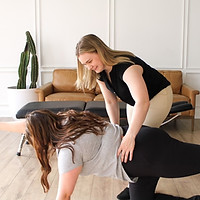Chiropractor and Physical Therapist for Jumper's Knee/Patellar Tendonitis in Carrollton, TX
Jumper's knee, also known as patellar tendinopathy or patellar tendinitis, is a condition characterized by pain and inflammation in the patellar tendon, which connects the kneecap (patella) to the shinbone (tibia). This condition is commonly seen in athletes, particularly those involved in activities that require repetitive jumping and landing, such as basketball or volleyball. However, it can also occur in individuals engaged in other sports or activities that involve frequent, intense leg movements.
What Causes Jumper's Knee?
Jumper's knee is considered an overuse injury, where repetitive stress on the patellar tendon leads to microscopic tears and inflammation. Factors contributing to the development of jumper's knee include:
Repetitive jumping: Activities like jumping and landing put significant strain on the patellar tendon.
Muscle imbalances: Weakness or imbalances in the quadriceps and hamstring muscles can contribute to increased stress on the patellar tendon.
Training errors: Rapid increases in the intensity or duration of physical activity without proper conditioning and rest can contribute to overuse injuries.
Symptoms of Jumper's Knee - What does it feel like?
Pain below the kneecap: The primary symptom is pain, often located just below the kneecap. The pain may be gradual in onset and worsen with activities that involve jumping, running, or kneeling.
Tenderness: The area around the patellar tendon may be tender to the touch.
Stiffness and swelling: Some individuals with jumper's knee may experience stiffness and swelling around the knee.
How Can a Chiropractor or Physical Therapist Help with Jumper's Knee/Patellar Tendonitis?
Soft tissue work and specific rehabilitation or physical therapy exercises are helpful to reduce these symptoms. Extracorporeal shockwave therapy and dry needling can be very effective in the area to reduce symptoms more quickly. Chiropractic manipulation around the pelvis, hip and knee can be beneficial as well.
Chiropractic & Physical Therapy Services in Carrollton, TX
Why People Choose Our Chiropractic & Physical Therapy Clinic in Carrollton
Our patients consistently share that what sets us apart is our thoughtful, personalized approach to care. Our doctors take the time to listen, understand the root cause of pain, and create treatment plans tailored to each individual, whether you’re recovering from a sports injury, managing chronic pain, or simply want to move better in your daily life.
Personalized, One-on-One Care
Every visit is 45 minutes or more, never rushed, and fully focused on you.
Root-Cause Approach
We don’t just treat symptoms. We identify and treat the source of pain for lasting relief.
Comprehensive Treatment Options
From chiropractic adjustments and physical therapy to dry needling, shockwave, and soft tissue work...all in one place.
Athlete-Informed Expertise
Our doctors are athletes themselves and understand the unique demands of training and performance.
Real Results That Last
Patients experience measurable improvements in pain, mobility, and strength, often within just a few visits.
Education & Prevention
We empower you with exercises, movement tips, and maintenance plans to stay pain-free.
Trusted by All Ages & Activity Levels
From weekend warriors to lifelong athletes, our patients feel supported and seen.
Compassionate, Down-to-Earth Team
Friendly, professional, and genuinely chiropractors and physical therapists who are invested in your health and goals.
Modern, Evidence-Based Care
We invest in our own continuing education and combine the latest techniques and technology with years of hands-on experience.
Life-Changing Results
Our patients describe their care as “transformative,” “life-saving,” and “the best they’ve ever experienced.”
Insurance & Pricing
We accept and are contracted with certain health insurance companies. We are in network with BlueCross BlueShield and United Healthcare. We are more than happy to run your benefits and see if we are considered in network and what those costs would look like. Otherwise, we do allow time of service cash rates as well if you do not want to use insurance or if you do not have insurance.
We accept health insurance, FSA and HSA.













